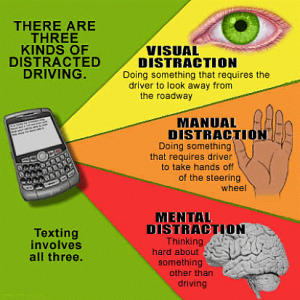
Distracted Driving: Safety Talk about Cell Phones
Using cellphones or other devices while driving has proven to be deadly. Cell phone use during driving is very prevalent on our roads today. In fact, at any given time throughout the day, approximately 660,000 drivers are attempting to use their phones while behind the wheel of an automobile.
Smartphones have made it easy for us to stay connected at all times. But that can pose serious safety risks if someone decides to check his or her text messages, emails, phone calls, or any other mobile applications while driving.
Some Statistics about Cell Phone Use and Driving:
- The National Safety Council reports that cell phone use while driving leads to 1.6 million crashes each year.
- In 2013, 3,154 people were killed in distraction-related crashes.
- Nearly 330,000 injuries occur each year from accidents caused by texting while driving.
- 1 out of every 4 car accidents in the United States is caused by texting and driving.
- Texting while driving is 6x more likely to cause an accident than driving drunk.
- Answering a text takes away your attention for about five seconds. Traveling at 55 mph, that’s enough time to travel the length of a football field.
- Texting while driving causes a 400% increase in time spent with eyes off the road.
Mitigation Actions for Distracted Driving:
- Put the cell phone down while driving.
- Put your cell phone on airplane mode if needed to eliminate distractions as well as the urge to answer a text, call, or email alert.
- If you need to text or call while driving, pull over to a safe area to do so.
- When traveling as a passenger, urge any driver who is using their cell phone to put it down.
- If there is another driver on the road who is using a phone while driving, maintain a safe distance from them and be a defensive driver. Always leave yourself an out in case of any type of accident occurs around your vehicle.

